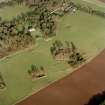Mordington, Old Parish Church, Burial-ground With Burial Vault
Burial Ground (Period Unassigned), Burial Vault (17th Century), Inscribed Stone (17th Century)
Site Name Mordington, Old Parish Church, Burial-ground With Burial Vault
Classification Burial Ground (Period Unassigned), Burial Vault (17th Century), Inscribed Stone (17th Century)
Alternative Name(s) Mordington House Policies; Kirk Park
Canmore ID 260105
Site Number NT95NE 6.01
NGR NT 95118 55887
Datum OSGB36 - NGR
Permalink http://canmore.org.uk/site/260105
- Council Scottish Borders, The
- Parish Mordington
- Former Region Borders
- Former District Berwickshire
- Former County Berwickshire
NT95NE 6.01 95118 55887
Scheduled (with NT95NE 10) as 'Mordington, medieval village and church 210m S of Mordington House... the remains of Mordington village, an abandoned later medieval settlement, and the site of Mordington parish church and its associated burial ground.'
Information from Historic Scotland, scheduling document dated 18 January 2010.
Field Visit (4 May 1912)
268. Burial Vault, Mordington.
The old church of Mordington was situated in a plantation about 160 yards to the south of Mordington House. The church is now razed to the ground, but a burial vault, which stood against the east gable, still remains. It measures 19 feet 2 inches by 12 feet internally. Built into the interior side of the west wall is a panel measuring 23 inches by 15 inches, on which is carved a rudely sculptured representation of the Crucifixion, with the incised inscription IHUS MARIA above (fig. 145 [DP 225417]). The crucified figure is pendent from the arms, and the feet are separated. This latter is a very early convention, the placing of one foot above the other in crucifixes being subsequent to the 12th century, but in the present case it is an archaism. Flanking the cross on the dexter side is a figure of the Virgin with hands clasped in prayer, and above is carved a lily; on the sinister side St John is portrayed bearing apparently a book, and a thistle is carved above. A roundel on either side of the cross shaft symbolises the sun and moon. Various data suggest the late 15th century or early 16th century as the probable date.
On a stone lying apart, which apparently formed the apex of the east gable of the vault, are the letters AM set in a rebus, which possibly stand for Anne, Lady Morthingtoun, wife of Sir James Douglas, created 1st Lord Morthingtoun or Mordington on 14th November 1641. On another stone are carved the letters W·M· (for William, 2nd Lord Morthingtoun) (1), and the date 1662.
See Ber. Nat. Club, 1890-91, p. 160 (plan and illus.); Carr's Coldingham, p. 152 (illus.); (1) Crawfurd's Peerage of Scotland, p. 350.
RCAHMS 1915, visited 4th May 1912.
OS Map: Ber., xviii. NW.
Sbc Note (15 April 2016)
Visibility: Standing structure or monument.
Information from Scottish Borders Council


































































